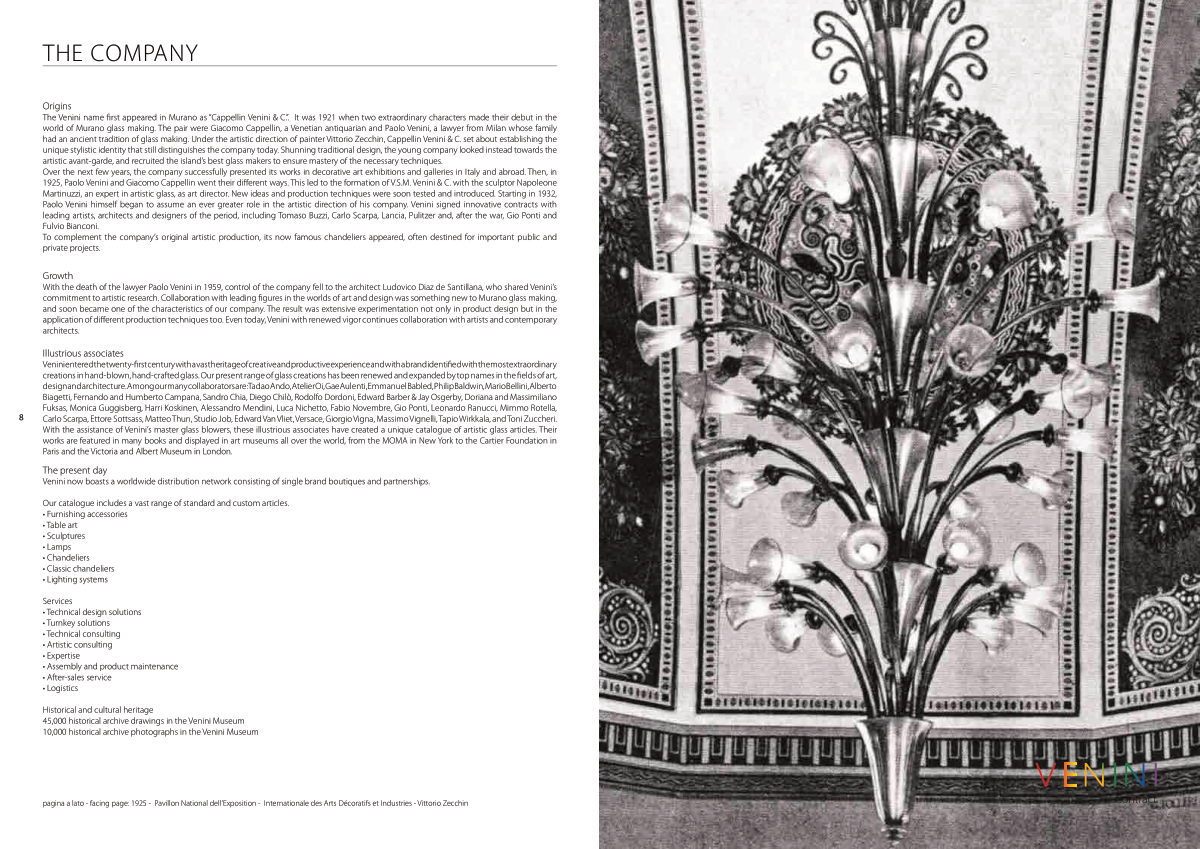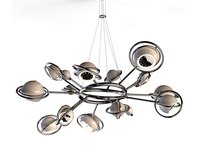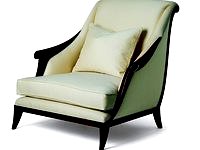8
Contract
THE COMPANY
Origins
The Venini name first appeared in Murano as “Cappellin Venini & C.”. It was 1921 when two extraordinary characters made their debut in the
world of Murano glass making. The pair were Giacomo Cappellin, a Venetian antiquarian and Paolo Venini, a lawyer from Milan whose family
had an ancient tradition of glass making. Under the artistic direction of painter Vittorio Zecchin, Cappellin Venini & C. set about establishing the
unique stylistic identity that still distinguishes the company today. Shunning traditional design, the young company looked instead towards the
artistic avant-garde, and recruited the island’s best glass makers to ensure mastery of the necessary techniques.
Over the next few years, the company successfully presented its works in decorative art exhibitions and galleries in Italy and abroad. Then, in
1925, Paolo Venini and Giacomo Cappellin went their different ways. This led to the formation of V.S.M. Venini & C. with the sculptor Napoleone
Martinuzzi, an expert in artistic glass, as art director. New ideas and production techniques were soon tested and introduced. Starting in 1932,
Paolo Venini himself began to assume an ever greater role in the artistic direction of his company. Venini signed innovative contracts with
leading artists, architects and designers of the period, including Tomaso Buzzi, Carlo Scarpa, Lancia, Pulitzer and, after the war, Gio Ponti and
Fulvio Bianconi.
To complement the company’s original artistic production, its now famous chandeliers appeared, often destined for important public and
private projects.
Growth
With the death of the lawyer Paolo Venini in 1959, control of the company fell to the architect Ludovico Diaz de Santillana, who shared Venini’s
commitment to artistic research. Collaboration with leading figures in the worlds of art and design was something new to Murano glass making,
and soon became one of the characteristics of our company. The result was extensive experimentation not only in product design but in the
application of different production techniques too. Even today, Venini with renewed vigor continues collaboration with artists and contemporary
architects.
Illustrious associates
Venini entered the twenty-first century with a vast heritage of creative and productive experience and with a brand identified with the most extraordinary
creations in hand-blown, hand-crafted glass. Our present range of glass creations has been renewed and expanded by top names in the fields of art,
design and architecture. Among our many collaborators are: Tadao Ando, Atelier Oi, Gae Aulenti, Emmanuel Babled, Philip Baldwin, Mario Bellini, Alberto
Biagetti, Fernando and Humberto Campana, Sandro Chia, Diego Chilò, Rodolfo Dordoni, Edward Barber & Jay Osgerby, Doriana and Massimiliano
Fuksas, Monica Guggisberg, Harri Koskinen, Alessandro Mendini, Luca Nichetto, Fabio Novembre, Gio Ponti, Leonardo Ranucci, Mimmo Rotella,
Carlo Scarpa, Ettore Sottsass, Matteo Thun, Studio Job, Edward Van Vliet, Versace, Giorgio Vigna, Massimo Vignelli, Tapio Wirkkala, and Toni Zuccheri.
With the assistance of Venini’s master glass blowers, these illustrious associates have created a unique catalogue of artistic glass articles. Their
works are featured in many books and displayed in art museums all over the world, from the MOMA in New York to the Cartier Foundation in
Paris and the Victoria and Albert Museum in London.
The present day
Venini now boasts a worldwide distribution network consisting of single brand boutiques and partnerships.
Our catalogue includes a vast range of standard and custom articles.
• Furnishing accessories
• Table art
• Sculptures
• Lamps
• Chandeliers
• Classic chandeliers
• Lighting systems
Services
• Technical design solutions
• Turnkey solutions
• Technical consulting
• Artistic consulting
• Expertise
• Assembly and product maintenance
• After-sales service
• Logistics
Historical and cultural heritage
45,000 historical archive drawings in the Venini Museum
10,000 historical archive photographs in the Venini Museum
pagina a lato - facing page: 1925 - Pavillon National dell’Exposition - Internationale des Arts Décoratifs et Industries - Vittorio Zecchin







